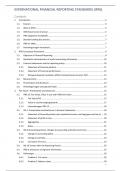Summary
Samenvatting International Financial Reporting Standards (IFRS)
- Course
- Institution
Dit is een samenvatting van het vak IFRS, bestaande uit de inhoud van de slides (in het blauw) en mijn aantekeningen uit de lessen (in het zwart). Hierbij worden eveneens de opgeloste oefeningen toegevoegd.
[Show more]



